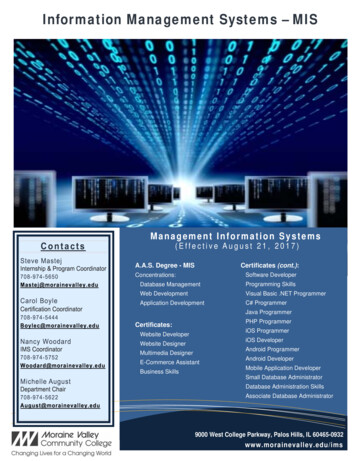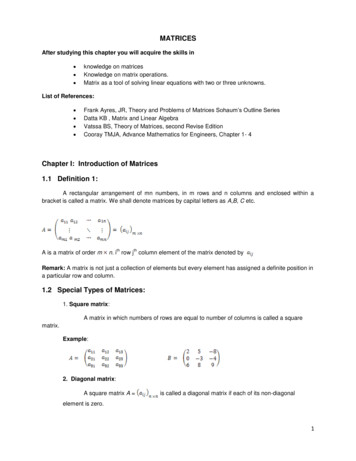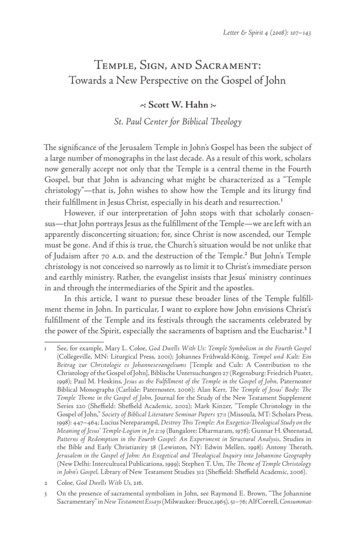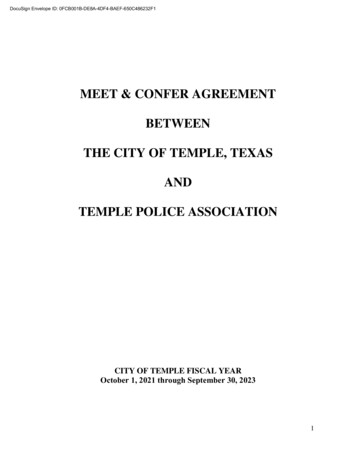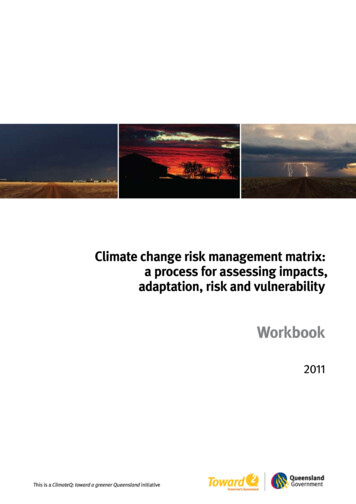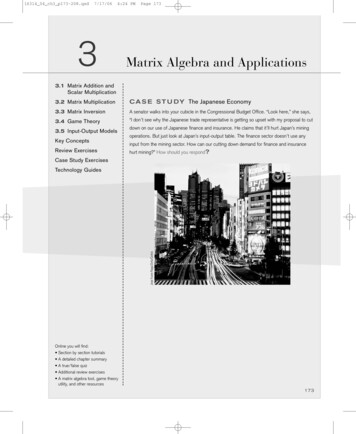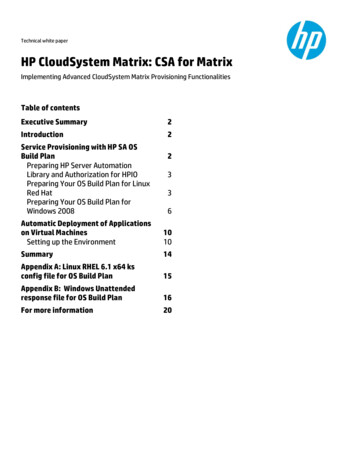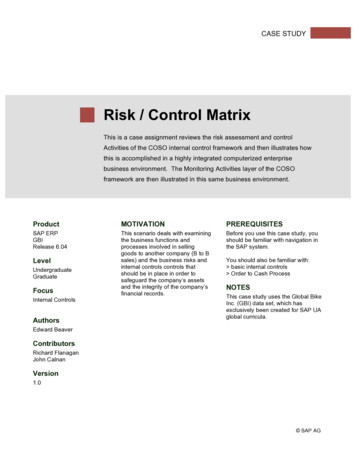
Transcription
CASE STUDYRisk / Control MatrixThis is a case assignment reviews the risk assessment and controlActivities of the COSO internal control framework and then illustrates howthis is accomplished in a highly integrated computerized enterprisebusiness environment. The Monitoring Activities layer of the COSOframework are then illustrated in this same business environment.ProductMOTIVATIONPREREQUISITESSAP ERPGBIRelease 6.04This scenario deals with examiningthe business functions andprocesses involved in sellinggoods to another company (B to Bsales) and the business risks andinternal controls controls thatshould be in place in order tosafeguard the company’s assetsand the integrity of the company’sfinancial records.Before you use this case study, youshould be familiar with navigation inthe SAP system.LevelUndergraduateGraduateFocusInternal ControlsAuthorsYou should also be familiar with: basic internal controls Order to Cash ProcessNOTESThis case study uses the Global BikeInc. (GBI) data set, which hasexclusively been created for SAP UAglobal curricula.Edward BeaverContributorsRichard FlanaganJohn CalnanVersion1.0 SAP AG
CASE STUDYAssignment OverviewThe scenario follows a logical approach to analzing business process risks and non-security internalcontrols to address or mitigate these risks consistent with the COSO internal control framework.There are 5 steps in this process / exercise. Part 6 of the assignment relates to each team member’swork in support of the team submission for this and other prior exercise.Part 1: Analyze and define the key risks that exist for the Order to Cash (OTC) process at GBIPart 2: Guided by the risks you identified (esp. the High Severity and High Likelihood / Frequencyrisks) identify the key controls that will be used in the OTC process.Part 3: Link the Risks from Part 1 to the controls in Part 2.Part 4: Complete definition of the controls (classifications, links to assertions, etc.)Part 5: The control activity description is not sufficient to assure the control process and relatedauditing process is understood and active. In Part 5 (leveraging some examples in the Appendix) youmust write auditable control process documentation for either one (1) manual or one (1) automated(configuration) control you identified.Risk Assessment and Other ControlsGBI is very concerned about security and information assurance. Due to the passage of the SarbanesOxley law, GBI realizes that solid financial accounting controls are extremely important for thecorporation. Originally GBI trusted the process and the people completing the tasks in the process aseffective enough internal controls.However, after implementing the ERP sytem at GBI, there is realization that a thorough review of theprocess, risks, controls, etc. is needed to truly assure GBI has the internal controls necessary tosatisby the requirement of the Sarbanes-Oxley lay and many others laws and regulations.An organization must do a detailed assessment of the risks involved with any business process andthen determine the likelihood of that risk occurring and the severity of the risk if it should occur.These factors will then be used to decide what controls should be implemented in order to mitigatethe risk.To complete the definition of the controls, detailed documenatation of the manual process that is usedmust be created. For configuration controls, a review / auditing process must be created. Thisdocumentation is required to assure each control is fully understood, taught, active and auditable.This ddocumentation in total is needed by GBI to assure good process operation that can be auditedand certified in control by the auditors of GBI.Company BackgroundGlobal Bike Inc., (GBI) is a world class bicycle company serving the professional and “prosumer”cyclists for touring and off-road racing. GBI’s riders demand the highest level of quality, toughnessand performance from their bikes and accessories. SAP AGPage 2
CASE STUDYProduct development is the most critical element of GBI’s past and future growth. GBI has investedheavily in this area, focusing on innovation, quality, safety and speed to market. GBI has an extensiveinnovation network to source ideas from riders, dealers and professionals to continuously improve theperformance, reliability and quality of its bicycles.In the touring bike category, GBI’s handcrafted bicycles have won numerous design awards and aresold in over 10 countries. GBI’s signature composite frames are world-renowned for their strength,light weight and easy maintenance. GBI bikes are consistently ridden in the Tour de France and othermajor international road races. GBI produces two models of their signature road bikes, a deluxe andprofessional model. The key difference between the two models is the type of wheels used,aluminum for the basic model and carbon composite for the professional model.GBI’s off-road bikes are also recognized as incredibly tough and easy to maintain. GBI trail bikes arethe preferred choice of world champion off-road racers and have become synonymous withperformance and strength in one of the most grueling sports in the world. GBI produces two types ofoff-road bike, a men’s and women’s model. The basic difference between the two models is thesmaller size and ergonomic shaping of the women’s frame.GBI also sells an accessories product line comprised of helmets, t-shirts and other riding accessories.GBI partners with only the highest quality suppliers of accessories which will help enhance riders’performance and comfort while riding GBI bikes.For purposes of this assignment, we will focus on the process involved in sales of in-stock, standard,off-road bicycles. GBI uses an open invoice system to bill its customers; that is, the customer is billedand must pay for each order separately as opposed to the customer being billed periodically for allorders made during that period (usually referred to as cycle billing).Standard Order to Cash Business ProcessTasks within business processes may vary considerably depending on the level of automation and theassociated technology. For instance, in a manual system, the task of recording a transaction may beaccomplished by either entry into a journal or by the “filing” of a copy of a multi-copy form. In anautomated system, “recording” entails the “filing” or storage of the transaction in the AIS. This issometimes accomplished by pressing a “save” button after entering the transaction into the system.The order of the tasks will also differ depending on the extent of automation within the system.Assume that GBI has recently converted from a manual system to a process the leverages the use ofan ERP system (e.g. SAP). The company uses the following 24 steps when they sell standard goods tothe customers. Note for organization and process optimization purposes, GBI has chosen to define 4sub-processes within the broader Order to Cash (OTC) process.Sub-Process: Order Receipt & Handling (OR&H)1. A customer sends a purchase order for off-road bicycles to a GBI employee.2. A GBI employee compares the customer’s purchase order to determine if the customer’smaster data is in the system and is correct. SAP AGPage 3
CASE STUDY3. If the customer master data is not in the system or is incorrect, then the master sales anddistribution data (such as company address, contact person, phone numbers, etc.) for thecustomer is entered or maintained in the ERP system.4. If the customer master data is not in the system or is incorrect, then the financial data (such asbanking information and GBI reconciliation account number) for the customer is entered ormaintained by a GBI employee in the ERP system5. If the customer master data is not in the system or if the customer would like to change creditterms or limits, then a GBI employee checks the credit rating of the customer and assigns acredit limit and credit terms in the ERP system.6. A GBI employee creates a sales order in the ERP system.7. If during creation of the sales order an ATP failure exists (e.g. inventory not available) A GBIemployee reviews the order requirements with Supply Chain planning to determine bestdecision (e.g. adjust plans, notify customer of valid delivery date, etc.).8. A GBI employee creates order acknowledgement & sends to the customer using ERP system.Sub-Process: Material Flow (MF)9. A GBI employee creates a delivery document in the ERP system and prints picking ticket tofill the customer’s order.10. A GBI employee physically picks the goods (the bicycles) from the picking ticket.11. A GBI employee creates a packing slip and a mailing label using the ERP system.12. A GBI employee puts the packing slip into a reinforced packing container with the goods,seals the container and adheres the mailing label to the container.13. A GBI employee moves the goods from the inventory control area to the shipping dock.14. A GBI employee prints a shipping manifest using the ERP system.15. A GBI employee places the goods to be shipped on the truck.16. A GBI employee gives the shipping manifest to the truck driver.17. A GBI employee records that the goods have been shipped in the ERP system.Sub-Process: Customer Invoicing (CI)18. A GBI employee creates invoice with remittance advice in ERP system & sends to customer.Sub-Process: Payment Receipt and Handling (PR&H)19. A GBI employee receives the payment from the customer with the returned remittance advice.20. A GBI employee records the payment from the customer in the ERP system.21. A GBI employee takes all of the payments for that day and creates a deposit slip for the bank.22. A GBI employee deposits the cash in the bank.23. A GBI employee records the bank deposit.24. A GBI employee reconciles bank deposits, cash receipts and ERP system balances daily.Important Note – You are not allowed to change the above business process. That is, youcannot add, delete or modify any of the steps above. SAP AGPage 4
CASE STUDYPart 1 – Risk Analysis and DefinitionIn this part of the assignment you are required to review and analze the entire Order to Cash (OTC)process as practiced by GBI and identify the key risks to the GBI business during operation of thisprocess. The current OTC process design was outlined in the prior section.Using what you’re learned in class and in prior exercises (e.g. Exercise 4) analyze the Order to Cash(OTC) Process design and outline the key risks to the GBI business. Focus in Part 1 only on the risks(what could go wrong).Record your risks in the ‘Part 1 - GBI Risks’ tab in the exercise submission spreadsheet. Recordcolumns A through F in this Part 1 step (other columns will be addressed in future parts of theexercise). In analyzing and recording these risks you must:Ø Identify at minimum 25 risks in the processØ Identify at minimum 4 risks in each of the sub-processes of the overall OTC process. Thesesub-proccesses are:o OR&H: Order Receipt and Handlingo MF: Material Flow (shipping)o CI: Customer Invoicingo PR&H: Payment Receipt and HandlingBelow are the definitions of the columns to be completed.Risk #: A unique # assigned to the risk. The # includes the process (OTC) and indicator of ‘R’ forrisk. This column is pre-populated.Risk Description: Clearly define what the risk is and include enough information that a businessperson reading can understand how the risk might inpact the GBI business.Process: Order to CashSub-Process: See above. Note: there can be instances where a risks is associated with more than 1sub-process. If this is the case, enter all sub-processes the risk is associated with.Severity of Risk: Indidate using the scale below (also in submission spreadsheet) your assessment ofthe severity of the risk.Severity / ImpactPotential for severe fraud, signfificant impact on financialHigh Statement AssertionsPotential for moderate fraud, moderate impact on financialMedium Statement AssertionsNegligable or minor potential for fraud, Negligable or minorLow impact on financial Statement AssertionsLikelihood (Frequency) of Risk: Indidate using the scale below (also in submission spreadsheet) yourassessment of the likelihood / frequence this risk would occur for GBI. SAP AGPage 5
CASE STUDYLikelihood / FrequencyHigh Risk is probable / frequent. Likely to occurMedium Some manifestations of this risk may occur occasionallyManifestations of this risk are possible but not likely, remote,Low improbableNote: the submission spreadsheet has an example (in grey) of a potential risk for GBI.Risks have can affect the business in different ways and with different magnitude. The dimensions ofRisk Severity or Impact and Likelihood / Frequency of occurant help you discover the total impact ofthe risk to the business.The Risk Assessment chart below in a visual and verbal way indicates the total impact of the riskgiven different values of Risk Severity / Imact and Likelihood / Frequency. This chart can be usefulin defining which risks need internal controls defined vs. those where the risk is acceptable without adefined internal control. SAP AGPage 6
CASE STUDYPart 2 – Control Analysis and DefinitionIn this part of the assignment you are again focused on the Order to Cash (OTC) process as practicedby GBI (see prior sections). Using the risks you outlined in Part 1 and the total impact of the risk (seematrix in prior section), select the key controls you recommend that GBI implement as internalcontrols for GBI. Use what you have learned in class and in prior exercises (e.g. Exercise 4) toidentify potential controls and chose those that will be the most effective (key controls).Record the controls you choose in the ‘Part 2 - GBI Controls’ tab in the exercise submissionspreadsheet. Record columns A through E in this Part 2 step (other columns will be addressed infuture parts of the exercise). In analyzing and recording these controls you must:Ø Identify at minimum 15 controls for the processØ Indentify at least a mininmum of three (3) controls in each of the sub-processes of the overallOTC process. These sub-proccesses are:o OR&H: Order Receipt and Handlingo MF: Material Flow (shipping)o CI: Customer Invoicingo PR&H: Payment Receipt and HandlingØ At least two (2) of the controls must be Automated / Configured controlsØ At least one (1) control must be identified for all Risks identified in Part 1 as High Severity orHigh Likelihood / FrequencyBelow are the definitions of the columns to be completed in the ‘Part 2 - GBI Controls’Control #: A unique # assigned to the control. The # includes the process (OTC) and indicator of‘C’ for control. This column is pre-populated.Key Control Activity: Clearly define what activity will be completed with implementing this control.Process: Order to CashSub-Process: see aboveMethod: What method will be used to implement this control. Options are:M: Manual – using a defined procedure a person is responsible for completing this activity toimplement the control.A: Automated (Configured) – the ERP system using a configuration parameter willautomatically implement the control (Assure the activity occurs).fNote: the submission spreadsheet has an example (in grey) of a potential risk and control for GBI. SAP AGPage 7
CASE STUDYPart 3 – Control Definition: Link to Risks and AssertionsThe analysis of Part 1 (identify Risks) and Part 2 (identify controls) cannot be done in isolation ofeach other. Controls exist to remove or mitigate risks that exist.In Part 3 of this exercise, you must link the risks from Part 1 to the Controls identified for Part 2.Record the results of this linkage by providing data in columns G through I in the ‘Part 1 - GBI Risks’tab. Specifically enter the following information in these columns:Key Control Activity: The key control activity (column B value from the Part 2 – GBI Controls tab)that will address this business risk. Note: more than 1 control can address a given risk.Control Ref #’s: The control # (column A value from the Part 2 – GBI Controls tab) that will addressthis business risk. Note: more than 1 control can address a given risk.How does the Control Address / Mitigate the Risk?: Briefly describe how the control addresses thebusiness risk.Notes:-The submission spreadsheet has an example (in grey) of a potential risk and control for GBI.-A given control may be applicable to addressing more than 1 risk. In this case, the controlwill be listed only once in the Part 2 tab but multitple times in the Part 1 tab.-A given risk can be addressed, mitigated by more that 1 control. In this case, enter allcontrols that are applicable in the Key Control Activity and Control Ref #’s column.-Because Part 2 of the exercise only requires you to identify a minimum of 15 controls, not allrisks may have a control identified. For risks without a control defined enter a value:o Acceptable Risk – no controls will be developedo ‘TBD’ (To Be Determined) in all columns.-Controls must be identified and linked for all Risks identified in Part 1 as High Severity orHigh Likelihood / Frequency. SAP AGPage 8
CASE STUDYPart 4 – Control Definition DetailsThere are many important components to effectively implementing the controls that have beenidentified. In support of this implementation it’s useful to gather further information about thecontrols, classify them and identify ownership of their implementation and use.In Part 4 of this exercise, you will gather and supply information about each of the controls youidentified in in Parts 2 and 3. You will supply this information in columns F through AI in the ‘Part2 - GBI Controls’ tab of your framework submission spreadsheet.Specifically enter the following information in these columns:Control Description (continued)Frequency: The frequency at which this control ix exercised, used or performed when implemented.Choose the most appropriate value from this list:XDWMQAMultple times a dayDailyWeeklyMonhtlyQuarterlyAnnualControl Owner: The tile of the person in the organization who’s the ‘Owner’ of the control. TheOwner is person held responsible for assuring the following:Ø The control is properly implementedØ The control is performed as definedØ The control results are monitored and any remediations, adjustments, etc. actions arecompletedØ Certifyng the above actions are completed as required by company Internal ControlCertification policies.You can choose the appropriate owners from the Organization Summary in Appendix A or choose anappropriate other title you expect exists in the Global Bike Inc (GBI).Control Type: How does the control accomplish it’s goal? Choose the most appropriate value fromthis Control Activity: What is the key activity used to implement the control. Choose the mostappropriate value from this list:RAS SAP AGReconciliationAuthorization (Security)SOD (Segregation of Duties Safeguarding)Page 9
CASE STUDYMPMonitoring/ ReviewProcessing (within system)Financial Statement Assertions – These columns indicate how the control (and the risks theymitigate) impact the various assertions that GBI must made when publishing its results.Mark the impacted assertion(s) with and x.Risk Assessment – These columns allow you to judge the relative risk of implementing thecontrols. Note Risk in this context is not related to the Order to Cash Process or it’s risks (Parts 1 and3 of this exercise). These indicators relate to assessing the risk of implementing the controls only.Complex / Routine: Are the actions required to properly implement this control routine (commonlypracticed already) vs. Complex (requies new skills and expertise). Choose the most appropriatevalue from this list:CPRComplexModerate (Neither Complex or Routine)RoutineInherent Risk / Fraud Risk: What is the level of inherent risks or a risk of fraud related to this controlarea and the risks it mitigates? Choose the most appropriate value from this list:HMLHighMediumLowJudgement is Required: Level of judgement required to implement the control Choose the mostappropriate value from this list:HMLHighMediumLowHistory of Error: Has there been a history of error at GBI or similar companies in effectivelyimplementing this control. Choose the most appropriate value from this list:YNYesNoFinancial Statement Impact – These columns indicate which section of GBI financial statementscould be impacted if this control is not effectively implemented.GBI follows standard financial reporting practices. Therefore the definitions of these financialstatement sections can be found in standard financial statement reference materials.Mark the impacted assertion(s) with and x. SAP AGPage 10
CASE STUDYSome of the Section descriptions use abbreviations. The abbreviations and their definitions are:COGS - Cost of Goods SoldLT - Long Term ( 1 year)AP – Accounts PayableNotes:-The submission spreadsheet has an example (in grey) of a potential risk and control for GBI.-Complete the classification columns for each of the controls you identified. SAP AGPage 11
CASE STUDYPart 5 – Internal Control Process and Audit DocumentationValid and usable documentation is critical so good ERP system operations. This extends also tointernal control related process and audit documentation.Appendices 2 and 3 of this Exercise Guide include real documentation examples from the Procure toPay process at GBI. Specifically:-Appendix 2: example of documentation of an Automated Configuration Control and how it isaudited.Appendix 3: example of how a Manual Monitoring Control is implemented.Using these examples and format, create one example control document for one of your identifiedOTC process controls (Part 3).Submit the documentation either as separate Word document or insert as tab in SubmissionSpreadsheet.The following resources are available to you in determining the details for your documentation:§ Professor: in class, e-mail, phone (609-206-9783)§ Table TSTC (List of transaction codes – reports)§ Internet: some very good examples and ideas can be found by searching what others havedone. SAP AGPage 12
CASE STUDYPart 6 – Individual Team Member FeedbackThis section is not required in 2015.This ends the assignment. SAP AGPage 13
CASE STUDYAppendix 1: Global Bike Inc (GBI) Organization SummaryChief Executive Officer (CEO)PresidentVP of SalesDistrict Sales ManagersSales Account ExecutivesCustomer Service ManagerCustomer Master and Pricing CoordinatorsCustomer Service RepresentativesVP of Finance (Chief Financial Officer – CFO)Extrenal Auditing ManagerInternal Audit ManagerComputer Audit ManagerComputer AuditorsProcess Audit ManagerProcess AuditorsControllerFinancial Operations (Ops) ManagerFixed Asset Accounting Supervisor and AccountantsGeneral Ledger Accounting Supervisor and AccountantsInventory Accounting Supervisor and AccountantsAccounts Payable Supervisor and SpecialistsAccounts Receivable Supervisor and SpecialistsLine of Business Financial AnalystVP of Supply ChainProcurement ManagerProcurement BuyersProcurement SpecialistsProcurement Data SpecialistsSupply Chain Planning ManagerDemand Manager and Demand Planning Specialists SAP AGPage 14
CASE STUDYSupply PlannersDistribution PlannersSupply Chain Data SpecialistsLogistics ManagerInbound and Outbound Logistics ManagerLogistics Mode SpecialistsExternal warehouse ManagerZone Warehouse SpecialistsManufacturing / Plant ManagerPlant Supply PlanningPlant Operations ManagerShipping Supervisor & Shippers SAP AGPage 15
CASE STUDYAppendix 2:Example of Control Process and Auditing Documentation:Automated Configuration ControlInternal Controls ProcessDocumentationGlobal Bike Inc. (GBI)January, 2015Procure to Pay ProcessApplication & ProcessProcure to Pay Configuration: 3-way MatchLocation: GBI Corporate HeadquartersProcess OverviewThe procure to pay (P2P) process at Goblal Bike Inc. for material purchases encompasses thenormal procedures of:Ø Developing / entering a purchase requisition,Ø Converting the requisition into a purchase order (PO) to the vendor complete with pricing,delivery instructions, payment instructions, etc.Ø Receiving the goods shipped from the vendor (GR). Note: receipt is done with reference tothe original POØ Entering the invoice details from the vendor invoice (IR)Ø Match / reconcile the PO, GR and IR to verify within defined tolerances to determine the truepayment liability for GBI.Ø Pay the vendor per reconciled information and PU payment agreements.Control Purpose / ObjectiveThe quantity and value of these P2P documents: purchase order (PO), Goods Receipt (GR) andreceived vendor invoice (IR) needs (at the line item level) to match within defined corporatetolerances prior to vendor payment. Without these controls incorrect payments to vendors mayresults. SAP AGPage 16
CASE STUDYThe purpose of this document is to ensure the SAP system has been appropriately configured toenforce the match (3-way match) for all GBI companies vs. corporate management toleranceallowance intentions. If matching gaps are found, inquire with management as to the necessity ofchanging the configuration settings and/or determine procedures necessary to ensure impropervendor payments are prevented.Work ProcedureThe Configuration for 3-way match is revewed by any of the following methods:A. Access Configuration:1. Use config transaction SPRO and Following path below:SPRO- Materials Management- Logistics Invoice Verification- Invoice Block- SetTolerance Limits2. Go directly to the 3-way match configuration with transaction OMR6.3. The 3-way match configuration is stored in table V 169G. You can use table displaytransaction SE16N to review the configuration as well.B. Verify Configuration Exists: For each GBI company in scope the following Tolerance Keys needto exist:Ø DW: Quantity Variance when GR Qty ZeroØ DQ: Exceed Amount Quantity VarianceØ PP:Price VarianceØ BR:Percentage OPUn Variance (IR before GR)Ø BW: Percentage OPUn Variance (GR before IR)C. Verify Configuration Details / Tolerances: For each configured tolerance ensure the settings areappropriate, i.e. the tolerance limits are checked and the tolerance values match currentmanagement guidelines. (See Details below)Configuration for Quantity Variance (Q):Tolerance Key DW: blocks the Invoice when there is no corresponding GR for a line item of a PO.It prevents the invoice to be paid immediately to vendor.Example:PO Qty -100Vendor Provides Invoice first for 100 Qty .GR is Posted after few days of invoice PostingResult:As soon as the invoice is posted in the system the invoice gets blocked due to DW tolerance key &doesn’t allow the system to pay the invoice immediately. The Blocked invoice appears in MRBRreport & Buyer of the Purchase order takes the suitable Decision to ensure three way match. SAP AGPage 17
CASE STUDYTolerance Key DQ: Blocks invoice when there is Quantity discrepancyExample:DQ tolerance Config-5%PO Qty-100GR Qty-100Invoice Qty-150Result:Since the invoice quantity is higher than the PO quantity the invoice gets blocked due to DQtolerance Key. SAP AGPage 18
CASE STUDYConfiguration for Price Variance (P)Tolerance Key PP: Compares the price between purchase order & invoice with the Tolerance limitspecified in the configuration.Example:PP tolerance in Config-200 PO Price -1000 Qty-1GR-Qty1Invoice Price- 1400 Result:Invoice is blocked since the Invoice price is higher than the PO price (More than ToleranceSpecified.) SAP AGPage 19
CASE STUDYConfiguration for Order Price Quantity (OPQ)SAP provides two Tolerance Keys Tolerance Key BR (IR before GR) & Tolerance Key BW (GRbefore IR) to address the order price quantity scenarios.Tolerance Key BR (IR before GR): Invoice gets blocked if the Order Price Quantity variation ismore than the value specified in configuration. The system compares the ratio between quantitiesinvoiced in order price quantity units: quantity invoiced in order units vs. quantity ordered in orderprice quantity units: quantity ordered in order units.Tolerance Key BW (GR before IR): Invoice gets blocked if the Order Price Quantity variation ismore than the value specified in configuration. The system compares the ratio between quantitiesinvoiced in order price quantity units: quantity invoiced in order units vs. quantity ordered in orderprice quantity units: quantity ordered in order units. SAP AGPage 20
CASE STUDYTesting Details (including SAP Table and Configuration Entries)Table Name: V 169GConclusion:Notes:Test Date:Tester: SAP AGPage 21
CASE STUDYAppendix 3:Example of Control Process and Auditing Documentation:Manual Monitoring ControlInternal Controls ProcessDocumentationGlobal Bike Inc. (GBI)January, 2015Procure to Pay ProcessApplication & ProcessProcure to Pay Report Monitoring (Manual)Location: All GBI locations where procurement buyers workProcess OverviewThe procure to pay (P2P) process at Goblal Bike Inc. for material purchases encompasses thenormal procedures of:Ø Developing / entering a purchase requisition,Ø Converting the requisition into a purchase order (PO) to the vendor complete with pricing,delivery instructions, payment instructions, etc.Ø Receiving the goods shipped from the vendor (GR). Note: receipt is done with reference tothe original POØ Entering the invoice details from the vendor invoice (IR)Ø Match / reconcile the PO, GR and IR to verify within defined tolerances to determine the truepayment liability for GBI.Ø Pay the vendor per reconciled information and PU payment agreements.Control Purpose / ObjectiveFor various reasons the quantity and value of these P2P documents: purchase order (PO),Goods Receipt (GR) and received vendor invoice (IR) (at the line item level) may not match. 3way match automated controls will (within defined corporate tolerances) cause these documentsto block thus preventing vendor payment. SAP AGPage 22
CASE STUDYHowever, continous and proper monitoring of these blocked documents is critical to assure theP2P process works to
Risk / Control Matrix - Temple MIS . case study

